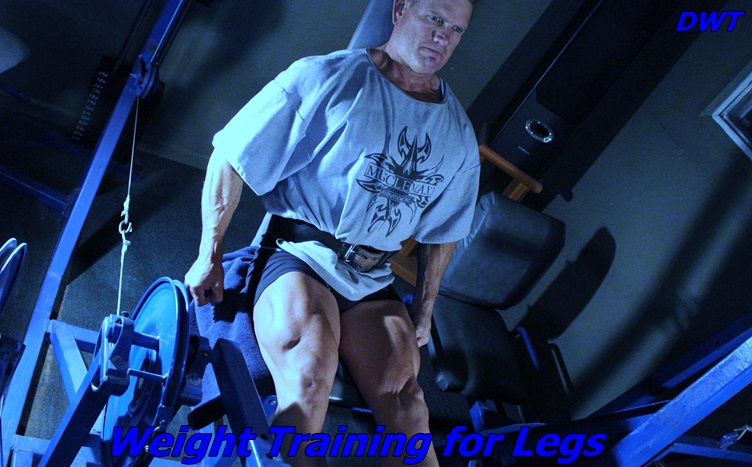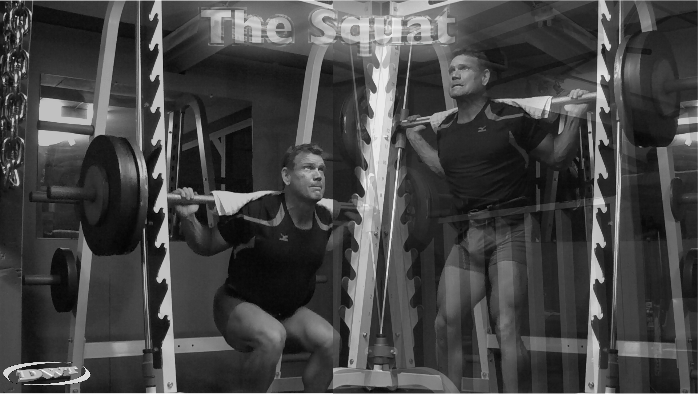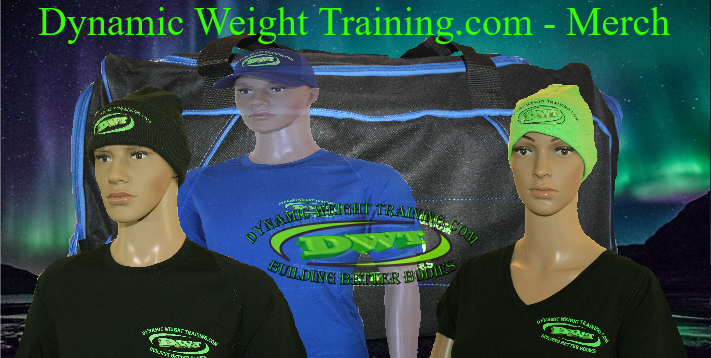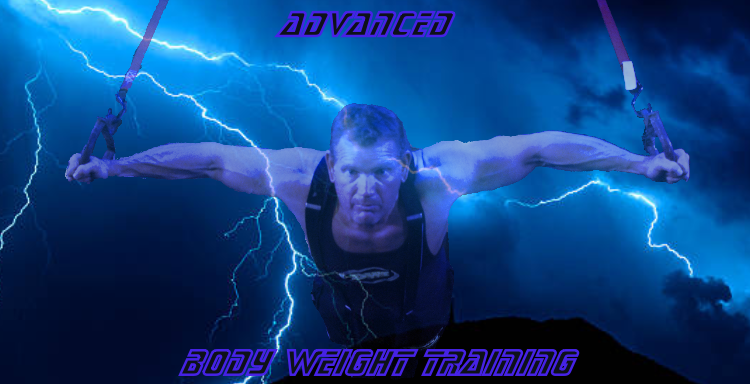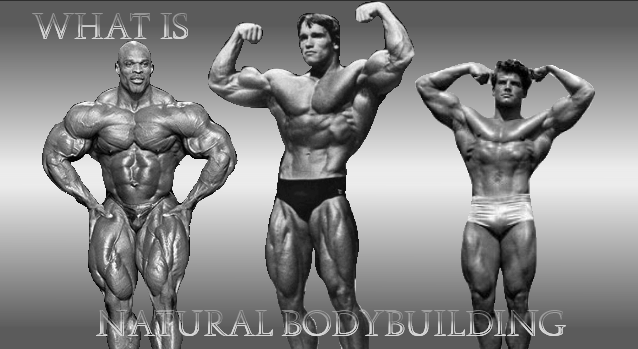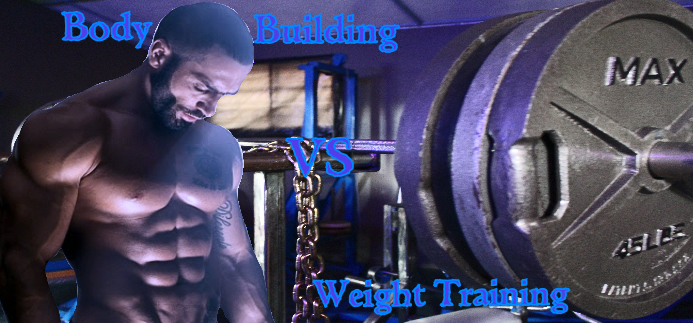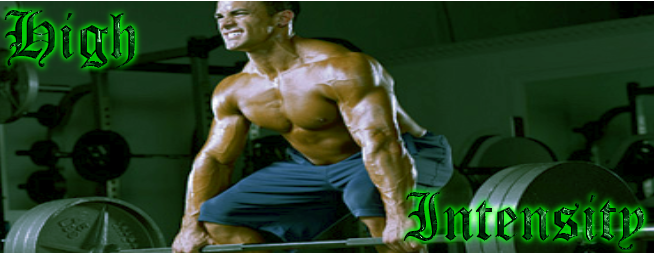Weight Training For Legs
When it comes to weight training for legs, a lot of beginners, intermediates, even advanced lifters in the early years, stay more squarely focused on building up the chest and arms to fill out the T-shirt.
There is nothing wrong with this, as we move forward with our strength and physic improvements made in our upper bodies... Surprisingly it doesn’t take long before we soon discover that the lower body is seriously lagging; pointing fingers and giggles at scrawny legs does little for a guys ego.
The reason for the most part, is quite simple, wise some guys don't train legs!
To reach any kind of strength or defining muscular achievement, the legs generally have to be trained on their own.
A new focused, mental attitude towards training them has to be adopted or they simply will not respond and develop in proportion to the amount of work that was committed to your upper body.
Why The Free Weight Area Is Quiet On Leg Day?
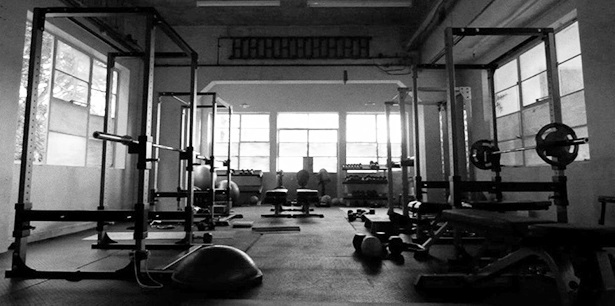
To sum it up: weight training for legs is not easy - regardless if you have trained them or not; instinctively, everybody knows leg muscles are powerful, they adapt quickly and it takes a lot to stimulate them. But...
Many great
things go along with this athletic conditioning of making the leg muscles
bigger, stronger, more powerful, defined and separated. This not only builds confidence and strength into all other
lifts you perform, in weight training...
This also affects your ability to be able to walk and run faster and adds a tremendous boost of efficiency to your favourite sports...
You should also understand the amount of calories that you will burn from leg training far exceeds anything you’ll burn from performing cardio.
Every type of training, including cardio could go into the classification of (easy), if you specifically compare it to leg training. But two great things emerge from a good leg training routine with regards to burning calories...
As mentioned, weight training for legs burns it's fair share of calories, Why? Because the leg muscles are big and powerful they have to be stimulated with vigorous intensity to see results, there is also something called the after-burn effect.
This is the amount of calories that your body will continue to burn after the initial leg workout, this can last up to 70 hours after the initial workout, depending how intensely you've trained them. That’s a tough calorie deficit burning program to compare anything else to.
So let’s go deeper into some of the different exercises and strategies for your leg day.
Beginners Weight training for Legs
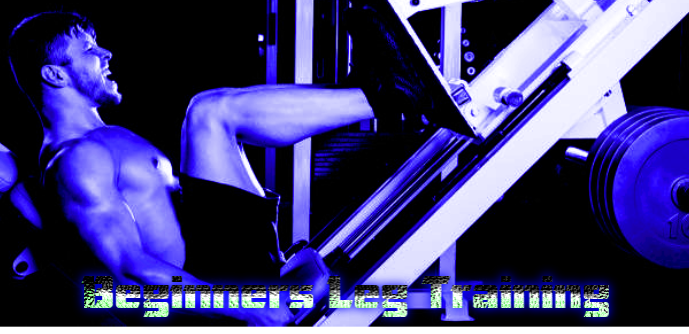
For beginners, you have some advantages over the intermediate level weight lifters.
Your strength and development curve is sharper than more advanced lifters, this is because: as a beginner your strength curve has nowhere to go but up; if you're consistent, and progressive.
Exercising caution on leg day, as you choose your poundage-level, avoid grossly exceeding your lifting level too quickly. Injury and sometimes even permanent or chronic injury can be direct result.
Get comfortable with with leg exercise movements and your natural strength levels before you progress.
Be sure to always warm-up, and your development will get there. Even better, you’ll get there, injury free.
Beginner’s weight training for legs routine:
let's start with 3 great compound movements to build leg strength.
Barbell Squats: performed with bar to the rear of the neck.
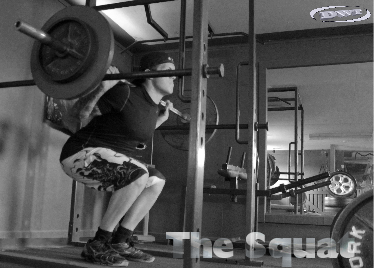
Set range - 2 Rep range 10 – 12, rest approx. 90 sec between sets.
Start with just a raw bar in the beginning with minimal resistance to build up good form in the squat.
- (lower in a controlled manner, having the leg biceps come parallel to the floor).
Smith Machine Squats:
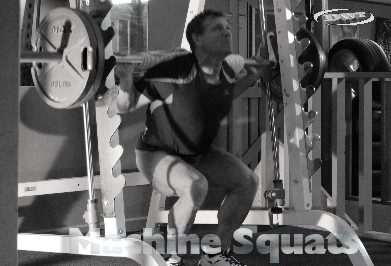
Set range - 2 Rep range 10 – 12, this is an exercise that can be used in place of the barbell squat, but...
should not become a substitute for building strength into your leg routine.
Rest between sets 90 sec. (this is a great exercise to build control and form).
The Leg Press:
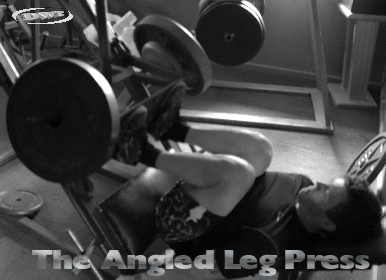
Set range 2 - 3 Rep range 10 – 12, don’t overload this machine, allow the quadriceps muscles to do the pushing.
Keep your butt firmly against the seat, don't allow your legs to lock-out at the top, keep the tension on the quads...
focus on a full range of motion with each rep. Rest 90 sec between sets.
Lying leg curls:
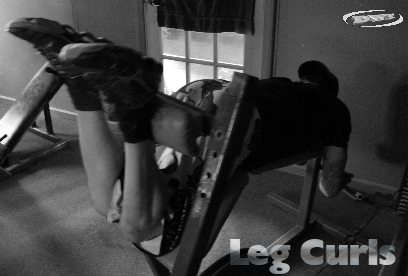
Set range 2 Rep range 8 – 10, last set 10 – 12 reps.
using a full range of motion on this exercise is important, keep your pelvic area tightly fastened to the bench.
Don't allow your butt to lift up, and squeeze the rear leg biceps for strong contraction at the end of each repetition), Rest 1 min.
Let The Goal Dictate Your Type Of Leg Training
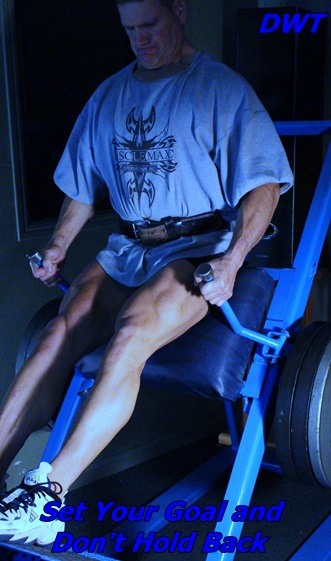
There is an important part in all weight training for legs exercises for men as in other body parts having a one-size-fits-all workout, is fine as a beginner -
with simple, basic exercises designed to build overall strength, endurance and conditioning to the legs.
But… as you move into the intermediate and advanced level lifting spectrum, you have to become more specific with regards to your leg training goals and lifting level.
What is meant by "allowing your goal to dictate what your leg training should be" is:
have your leg training routine set up so that it matches the goal?
Building Strength Into The Upper And Lower Legs
Be progressive choosing resistance to challenge, without sacrificing form with these exercise
Barbell squats:
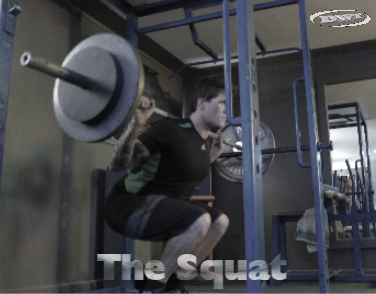
Set range-3 Rep range 4 – 6, performed with bar to the rear of the neck, training for sheer strength is different from that of training for pure mass.
Use the pyramid method of adding resistance to each new set, you complete especially; here on the barbell squat exercise.
Don't! train to failure, just be sure your Done at the end of your 4 to 6 reps.
Dead lifting with barbell:
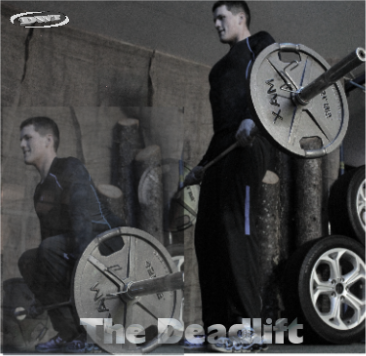
Set range 3 Rep range 4 – 6, using a reverse grip, arms should be just beyond shoulder width, to balance the bar properly.
Keep the shoulders back, your hips and butt-low.
As you begin to pull the bar upwards, keep it close to the shins so it barely clears the knees, make an effort to drive through the heels e.g.,
imagine pushing the floor from you instead of standing-up against it.
Barbell lunges:
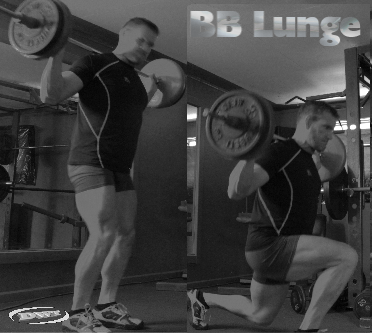
Set range 3 Rep range 6 –8 - per leg, The lung is a large step, having the toes beyond the knee as you lower.
This is a great compound exercise in the stretched position, this exercise also greatly increases strength, athletic power and agility in many sports.
Challenge yourself by using the pyramid method of adding resistance to each set, Don't train to failure but, keep your rep range in mind.
The vertical leg press:
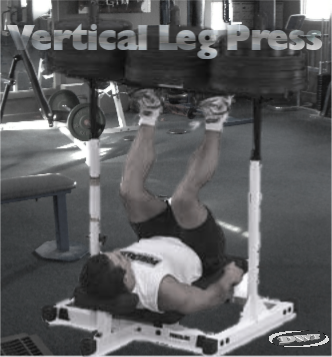
Set range 3 Rep range 5 – 7, not all gyms have this apparatus, if yours does, this exercise does produce great lower body strength results, if not, try the leg sled instead.
Before removing the safety stops, make sure your feet are well/solidly positioned on the machine.
This exercise really squeezes so make sure you're well warmed up before you start your maintenance sets, again, pyramid on each exercise.
Barbell Stiff Leg Dead lifts:
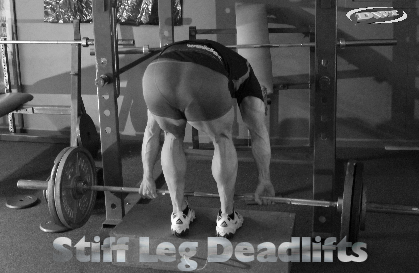
Set range 3 Rep range 5 – 7, in this exercise, try to keep the knees locked.
You may have to be on a block to lower the bar fully, with a reverse grip, starting at waist height, lower the bar close to the toes and return -
this exercise is great for strengthening the hamstrings, glutes, quads and shoulders.
Standing Calf Raises:
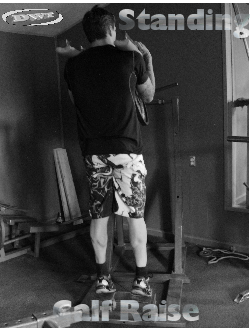
Set range 4 Rep range 8 – 10, the standing calf raise is a great classic extreme lower leg exercise designed for building sheer strength.
Hook just the toes over foot-pad and make sure the shoulders are firmly under the push-pads, keep your body as straight as a board...
this lines up strength and energy through the hips, shoulders and toes.
It's important on this exercise, to increase the overall strength of the calves by… Fully lowering the calves and fully extending on each rep.
Pyramid-up on this exercise.
Note: strength training and rest is somewhat different - you should allow for longer rests between sets, allowing your oxygen and the muscles it supplies to make a full recovery, before moving onto the next set. You may have to rest for a full 2 to 3 minutes or more to make a full recovery.
These exercises, in this routine, if performed with good form; this set and rep range will produce excellent strength and muscle conditioning results.
I'd suggest picking a few of the exercises shown here on each leg day. Try them out, see what you think. Experiment with your poundage's and rep ranges, to ultimately find which works best for you.
Building Size Into The Upper Legs
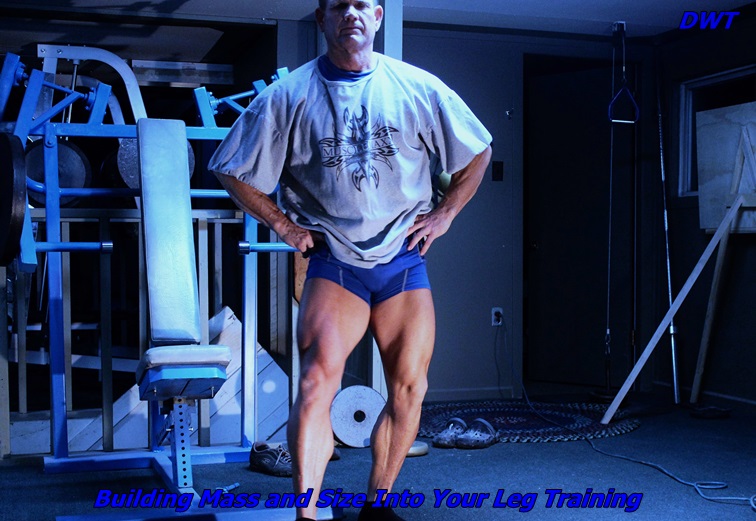
This has always been a largely debated subject... don’t be fooled, the legs are the biggest and most powerful muscles in your body period!
So how is
weight training for legs incorporated into a good leg routine, to build sheer size and mass to the upper legs?
The legs are comprised of many different muscle groups and fibrous attachments. With that said; the legs are strong and have incredible endurance and adaptive components to them...
Your leg training should have different exercise strategies cycled often so the legs continue to respond to the training your inflicting on them.
Before we begin to delve much deeper into building mass and size for the upper legs, there are five main components that should be understood before you take on any serious training for the legs.
- First: warm-up, this can be done, performing some light cardio, e.g. for 10-12 min. Some light stretching, and be sure to perform two or three warm-up sets. Don’t think of these warm-up sets as trivial or unimportant: they're not! Just don’t preform them to muscular failure. These sets will warm-up the muscles, joints, ligaments and tendons, including the fascia that surrounds them to prevent you from injury.
- Second: intensity, this is a largely used word, but seldom understood in its entirety with regards to weight training for legs. Once you move into heavier maintenance sets you should keep your form tight as possible and mentally focus specifically on the muscles your training, challenge them by going through a full range of motion; including a good stretch and strong contraction at the end of each repetition.
- Third: meal planning and nutrition comes into play here also, you should ingest enough complex carbs from good food sources to sustain your energy levels through intense leg workouts with pre and post work-out meal planning. Make a point of ingesting enough protein to assist with muscular repair to satisfy new growth demands inflicted by leg training.
- Fourth: Become adaptive and change the record, a lot of athletes can tend to miss this at times. As mentioned before, the legs are strong and highly adaptive. If you are on a specific leg routine for mass almost any leg training routine at the outset will probably only have enough adaptiveness to challenge you for no more than six to eight weeks.
- Fifth: there are mechanical rules that go along with building overall upper leg size and mass. To achieve your best results start by disciplining yourself to do the toughest exercises and the heaviest workloads at the beginning of each leg work out; while you’re fresh and energy stores are at their peak,
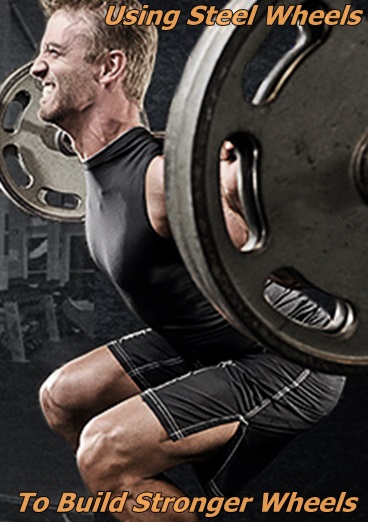
Try to keep the volume - meaning ‘the total number of sets and reps' - relatively high’. And keep the mindset of training very close to muscular failure.
Training legs is not complicated, but learning and mastering the different exercises can be.
To protect the knees, hips and lower back, I strongly urge you if you’re using heavy poundage’s to not allow this to last more than 6 or 8 weeks ‘provided you're training every week’...
The body needs a break from this kind of stress.
While you’re taking a break from heavy training, change the load resistance by 15 to 20% - lower and use some different exercises for the next 3 to 5 weeks. Then come back and pick up where you left off in your mass training routine.
This change will add new stress and a new adaptive process in your weight training for legs, forcing them to change.
Complete exercises for developing size and mass
The Angled Leg Press:
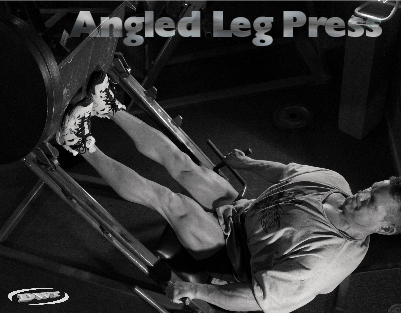
Set range 4 – 5 Rep range 6 – 8, machines make life easy.
Focus your attention to the powerful muscles of the quads as you're pushing, keep the energy in line with the hips and drive through the heels.
always change foot position, as shown here from inside to outside stances, Make every set and rep count, final set 10-12 reps ‘reducing resistance’.
Hack squats:
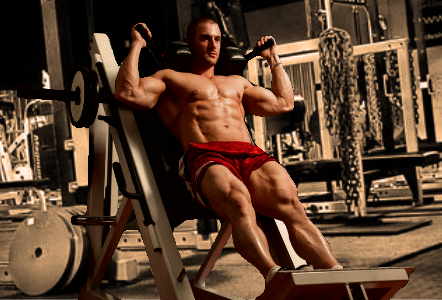
Set range 4 Rep range 6 – 8, the hack machine is a similar movement to the squat, but...
Because it's a machine, the nervous system doesn't have to focus on balance, like the free squat.
This machine is great for helping build size and shape into the lower part of the quadriceps around the knee. If you have carrot shaped legs?
This is a great exercise. Perform a drop set on last 2 sets e.g., try to get –10-12 reps.
Leg extensions:
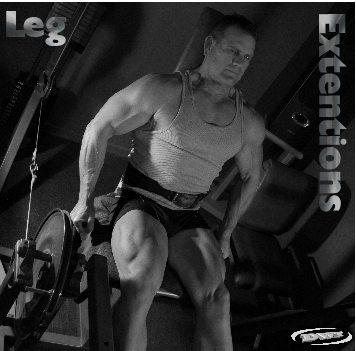
Set range 4 Rep range 7 – 9, the leg extension is more often thought of as, strictly a shaping exercise.
but the fact is; if you keep your reps low and resistance up there this exercise can act is a great mass and muscle shaper for the lower quads around the knee area.
Always make an attempt to exercise different toe positions, to emphasize inner and outer thigh development.
Note: ‘Perform single drop set on last two sets’.
Barbell squat:
Set range 4 Rep range 6 – 8, this exercise arguably is one of the best for building overall mass in the lower body, especially: for the big muscles of the quadriceps.
This exercise builds overall raw power and strength throughout the entire body. The only other compound exercise that can stand next to this one is the dead lift, perform a drop set in your final set at the end. Rotate foot position, and stance, even where you put your heels, just keep changing it, so you're constantly changing the angle that the quadriceps have to adapt to.
Walking lunges:
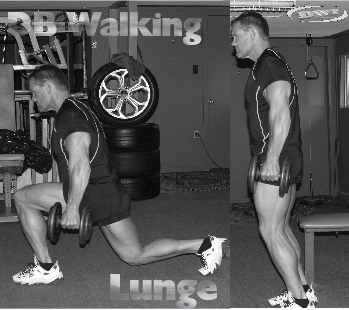
Set range 3 Rep range 8 - 10, (each leg), final set 10-12 ‘slightly reducing resistance’.
Normally I prefer to do lunges with slightly less dumbbell weight but perform them after each heavy squat movement, this way;
I force that last bit of blood into the quadriceps, for a final pump before I take my rest.
Consider building up to this intensity slowly.
Leg Curls For The Leg Biceps:
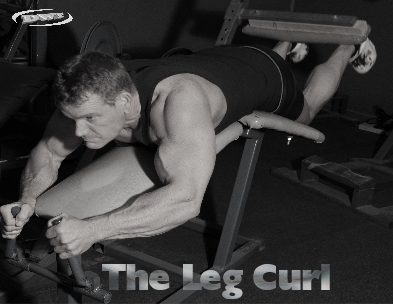
Set range 3 Rep range 8 – 10, make the last 2 sets a drop set.
As with all front and rear leg movements change heal angle and toe position on each set, forcing the inner and outer leg biceps to work harder at different angles.
Focus on the upper contraction, lower the legs as far as you can to feel a good stretch before your next rep.
Weight training for legs tip:
Be sure to warm-up well, choose 3 to 5 of the exercises for each work out, listed above and work on them progressively, as the muscles of the quadriceps and hamstrings become more conditioned; add more intensity for leg growth, by shortening rest intervals.
The Calf Muscles
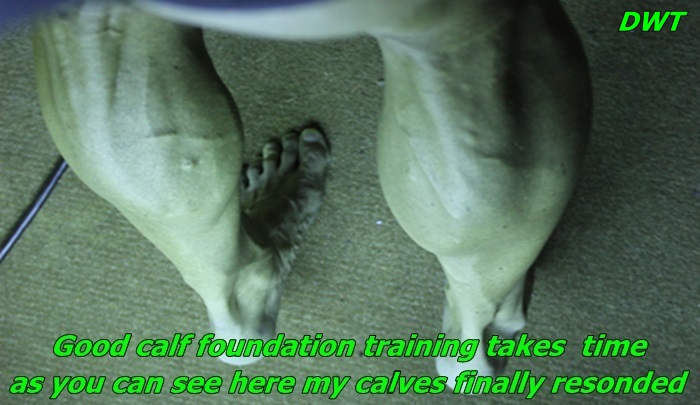
Angled leg press, calf raises:
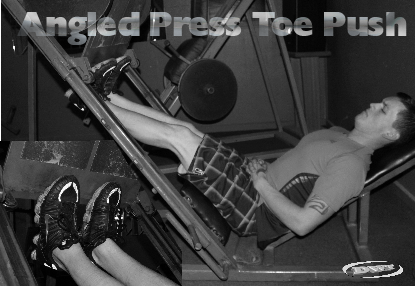
Set range 4 Rep range 10 – 12, final set 12 – 15, with one drop set.
As in all weight training for legs exercises, be sure to always have a firm stable, grip with your toes before releasing the safety stops.
Vary toe position, pointing toes inward and outward effectively works the calves from varying angles.
Standing Calf Raises:

Set range 4 Rep range 10 – 12, this exercise as mentioned above is great for strength and size results.
Make sure the shoulders are firmly under the push-pads, keep your body as straight as a board, as this lines up strength and energy through the hips, shoulders and toes.
This exercise is one you have to push the limits on, (calves are high-density and stubborn, you have to be persistent).
I often perform this exercise with the angled press calf raises as a super set, typically producing good results.
Seated Calf Raises:
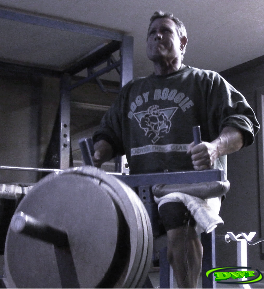
Sets Range 4 Rep Range 8 - 10, this exercise is great for developing the mass of the extreme outside and lower part of the Soleus...
It's location is the underlying muscle of the Gastrocnemius).
As in all lower leg training exercises, you have to commit to a full range of motion and be progressive with calf training,
Keep your goal and rep range in mind, be merciless on your intensity towards them.
Weight Training For Legs, Separation And Definition
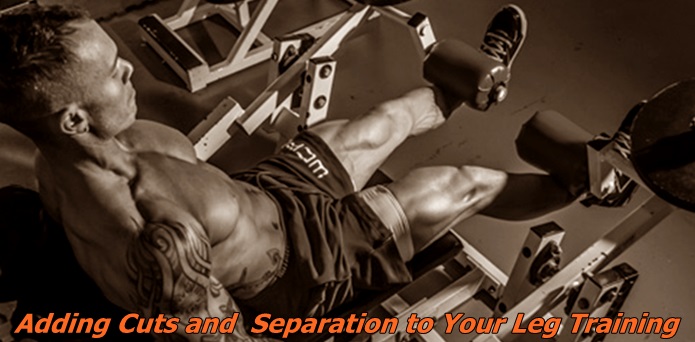
As with any muscle groups, adding, separation and definition. First: you have to have achieved enough muscle mass to be able to force separation and definition into them.
If you don’t understand this and you already have underdeveloped or somewhat skinny legs, and you wish to add definition to the overall look of your legs...
You’re going to wind up with even smaller, skinnier, looking ripped legs which do not have the same aesthetic appeal as well-developed muscular defined legs... this is of course is up to each individual as to what they find athletically appealing...
Just be aware that you cannot have one without the other so-to-speak, you also should become more aware of your caloric intake.
Just using lighter weights and performing a few more repetitions and sets will not necessarily add separation and definition to the leg muscles…
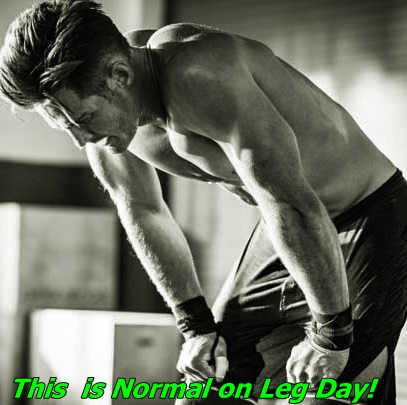
Note: when performing exercises for detail and definition: keep in mind you should be slightly decreasing the weight after the initial set, when performing a drop set with no more than a 5 - 8 second count between the original set...
Or eliminate the drop set and perform a super set.
Super sets e.g. are simply combining two different exercises with the same intensity with no rest, rest is taken after the initial two super sets.
You should be reaching muscular failure, within the 10 - 12 rep range. This type of training has more endurance and conditioning properties to it.
You are essentially removing and reducing unwanted water and fatty tissue, to add the final polish to your muscular gains.
With this type of training you are literally using a lot of oxygen and energy from calories, to burn cuts, symmetry and definition into the legs.
Adding separation Tip:
If you're approaching the 6 to 8 week mark and not seeing separation or bulging muscles from the quads, you may have to indulge in some cardio activity for 15 to 20 minutes, (exercise bike).
You could try riding every second or third day to start with: monitor your progress with selfies or the mirror.
The exercise bike doesn't burn a lot of calories, but does reduce some body fat and water retention in the legs. the bike is a great cardio exercise that focuses specifically on the legs.
Concluding:
No other muscles on the human anatomy can adapt and are more apt at building superhuman strength, than those muscles of the upper and lower legs...
Regarding weight training for legs: the legs for the most part will only respond to change and progressiveness of your leg training attitude...
Meaning: the only thing that should be regular with your leg training routine is: train with intensity and be constantly changing and cycling it!
The stresses of your training environment, meaning your routine and how creative and focused you are at attacking these muscles will decide the final outcome of how well developed and cut you can actually make your legs appear.
If you truly wish to develop and add separation and definition to the look of your lower body; fall in love with your legs, equally as much as you like training chest and arms, because ultimately it will be your legs that take you there.
Good luck with every set and contraction of every rep you force into your legs. This will be one of the greatest investments you make in your body. Simply because this is our sole mode of our transportation...
So keep those wheels greased and strong, I hope weight training for legs has helped you out, and good luck.
DWT
